

 |
 |
It all began in Maghera, N. Ireland on a freezing Winter ’s night back in 1996 when I stood upon the glittering oil tank at the back of my house and for some reason, perhaps the passage of a fleeting meteor or flaring satellite, I turned my head skyward and it was then that my life changed forever. Back then there was less light pollution so the sky over town and the adjacent countryside was exceptionally dark and as the frost smarted my eyes I became instantly star struck. I decided then and there that I wanted to know the sky so well that I would be able to name and identify all the stars at a casual glance. I vowed that on the following day I would visit the town library and acquire a book about the stars and begin my journey into the heavens. From the darkness of my back garden I used a red torchlight to preserve my night vision so that I could study the constellations in my book and compare them to the real sky above. I found I had a good memory for patterns and with a decent run of clear nights it wasn't long before I had learned many of the Winter constellations and could confidently allocate a bright star its name - 'Polaris' The North Star, 'Dubhe' in The Great Bear, 'Rigel' in Orion and 'Arcturus' in Boötes. That Christmas I got my very first telescope in the form of a white 2.5" aperture refractor and despite its small objective lens and shaky mount I managed to get my first view of planet Jupiter with its four bright moons followed by the magnificent rings of Saturn. I knew then that there would be no turning back and that the sky and its celestial happenings would be staying with me for the rest of my life.
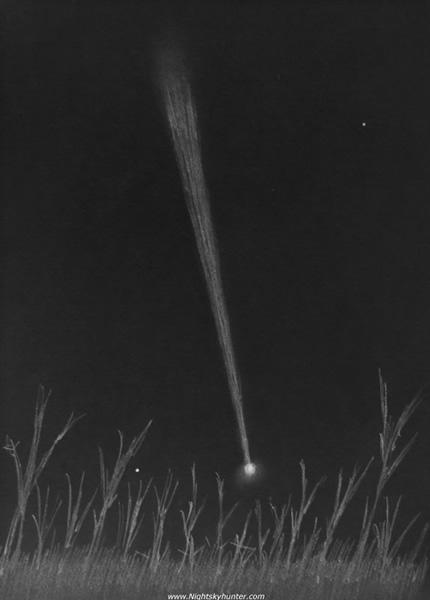 |
In March 1997 I was catching up with an old school mate, we drove through the countryside outside Maghera and parked at a very dark location and chatted about old times. Before dawn we stepped out from the car to get some fresh air and like my first encounter with the sky the previous year the ground was covered in a carpet of white frost. My friend and I looked to the east where an unforgettable sight greeted us. What we first mistook for a giant search light sitting among the stars turned out to be the great comet Hale-Bopp rising tail-first from behind a row of trees which lined the pre-dawn sky. This was my first ever encounter with a magnificent comet and the emotions the sighting triggered within stirred me deeply. The visual sight was both spectacular yet frightening. I shall never forget that ghostly fanning dust tail. It was this experience alone that would redirect my thoughts specifically towards comets and every other form of exciting transient phenomena I could hunt in the sky in the years to come.
I witnessed my first Aurora Borealis display from Maghera in 1997 from my bedroom window (I used to stay up all night long watching the sky). Suddenly one night a strange apparition of white and blue beams manifested from nowhere. The show was breathtaking and for a moment I thought it was the end of the world. However after a few hours of restless sleep I learned the next day from 'Astronomy Magazine' that I had just witnessed the Northern Lights. I couldn’t believe they could be seen from N. Ireland. Following on from that first sighting I have since observed 143 aurora displays. As I write this article in 2017 a lot has happened since those earlier days when I began to learn the sky. I have observed 63 comets and spent over 1073 hours searching for a new comet of my own.
Left) Sketch I did of C/2002 C1 Ikeya-Zhang at 20.19 UT on April 1st 2002 as seen through the 8" F/6.3 S. Cass. The comet had an active jet on one side and many bright tail streamers. At the time this was the best comet I had seen since Hale-Bopp and it was a beautiful sight with the naked eye in the western evening sky passing through Andromeda close to M31. I came within 20 degrees of discovering this new comet myself while completing an evening search with the same instrument on the day of it's discovery, I missed the discovery position due to low murk and LP in the southern sky. |
I have owned many telescopes including an 8” Meade LX10 S. Cassegrain, however my favourite telescope was a 16” Meade Starfinder Dobsonian reflector. This telescope was so big I could literally crawl inside the tube with room to spare. The views through this instrument were astonishing, especially of Messier 42 in Orion, The Swan Nebula in Sagittarius and the Veil Nebula in Cygnus, the latter being a remnant of an ancient supernova explosion which was momentarily so bright it outshone all the other 400 billion stars within our Milky Way Galaxy.
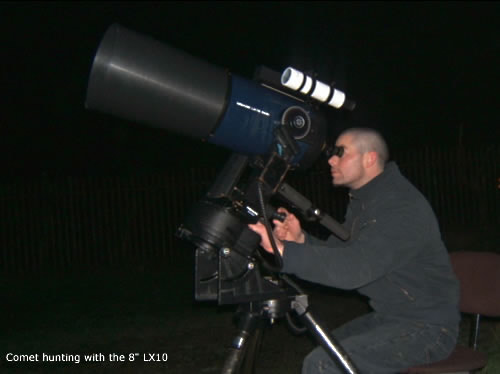 |
Left) DII
T7 (Right) |
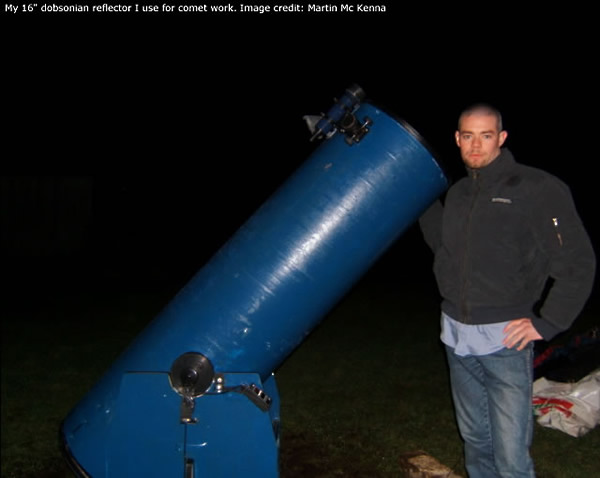 |
I gave everything a code name which aided with the speed of my log book records. The 8" was lovingly called DII which meant 'Discovery II', the first discovery name went to my smaller 90mm ETX. The 16" was T7 named after first light when the instrument was new, on that special night it was comet C/2002 T7 LINEAR. The above images bring back great memories when Conor McDonald and I spent many many hours under the stars on a nightly basis, sometimes for the entire night. Conor took these images for me at the time while I was hunting for comets in the middle of the night from my old back garden where I first saw the stars which changed my life.
DII was dripping with dew, a sure sign of excellent seeing for planetary observing, however it was probably coating my objective lens slowing down my comet search. When this happened we had to carry the heavy telescopes back up a hill to the garage where a hair dryer was waiting to remove any dew or frost from the lens, this had to be done with great caution though as the temperature difference can crack the glass, however I had it down to an art form, it's funny how all these memories come back as I write this.
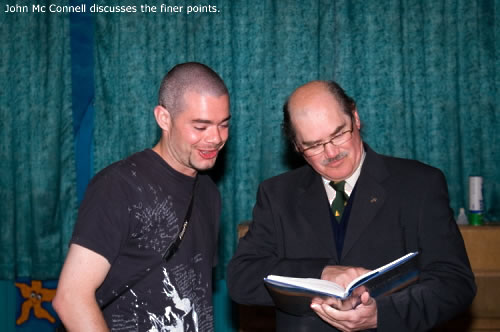 |
Left: John McConnell & I during my asteroid award
Right: John McConnell with his 8.5" reflector during his own asteroid award |
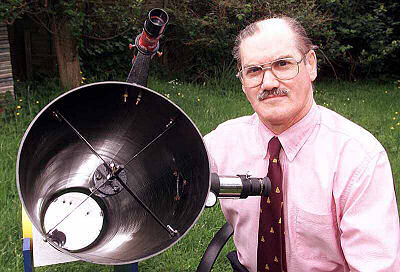 |
In 2005 I was awarded Astronomer of the year by IFAS (the Irish Federation of Astronomical Societies). Then I received the ultimate accolade when I got my name on an asteroid, now designated 42531 McKenna, by the International Astronomical Union in the USA, thanks to the support of Dr. David Asher from Armagh Observatory and astronomical historian John C. McConnell from Maghaberry. These were John's words on that special day which he kindly made a copy of...
...''you then proceed on his/her instructions to prepare a suitable citation, which has got even harder to do in recent years, as you are tied to about 300 characters, and that includes the comas, full stops etc. It is the discoverers privilege to then submit it to the Minor Planet Center, and hopefully the International Astronomical Union and Small Bodies Naming Committee will approve it. The recipient is one of the most meticulous and prolific observers we have come to know in recent years. Not only does his interest cover such a wide range of astronomical and meteorological subjects, but he has also spent almost 1000 hours searching for that illusive comet of his own. It is mainly for this dedication that he is awarded this great honour. And if you haven't already worked out to whom I refer, let me quote the official citation...
(42531) McKenna - 1995 L J Discovered 1995 June 5 by D.J.Asher at Siding Spring.
Martin McKenna (b.1978) was named 2005 Astronomer of the year by the Irish Federation of Astronomical Societies. An avid visual comet hunter and all round observer, he also undertakes a photographic search for novae. The name was suggested by J.C.McConnell.
Martin, it gives me enormous pleasure in announcing that asteroid (42531) 1995 L J has been officially named as (42531) McKenna.
Many congratulations! very well deserved!''
I could write a book about John McConnell and my own observing adventures and discussions with him however I will save that for another time. Over the years I have been treated to many incredible phenomena from meteor showers and shadow casting fireballs to the Zodiacal Light (a diffuse, almost eerie light which can sometimes be seen extending above the horizon just after dusk or before dawn) and Noctilucent Clouds (mysterious glowing clouds which can be seen in the night sky during Summer months). In 2004 I felt compelled to get my first digital camera, my reason being that I was seeing so many wonders in the sky from Maghera that I wanted to show them to others in the hope that they too would look up and enjoy nature at first hand. So it was with this purpose in mind that I got my first 1m pixel camera for Christmas and things took off from there in a major way. Thanks to the influence of my neighbour Conor McDonald I developed a keen interest in the weather, specifically storms. Conor’s passion was infectious and between the two of us we invested an incredible amount of time watching and photographing the weather by day and the stars by night. Before long this passion naturally progressed into a full obsession.
During the course of the past twenty years I have witnessed many spectacular phenomena and captured thousands of digital images. This love for the sky has never waned and I am as obsessive as ever in my quest to catch the next cool event on camera. I truly love nature and even though I have been all over the country in my quest for the next big event I feel proud that my roots began in Maghera which showed me the way to the Heavens and a life time of joy and wonder. The following is a short example of the various images I have taken from Maghera and the surrounding area. It is my hope that my passion will awaken a similar enthusiasm and delight in some of you and that perhaps someone else will pick up a camera and document the sky over their own home town or village.
NIGHT SKY PHOTOGRAPHY
Drumlamph Star Trail
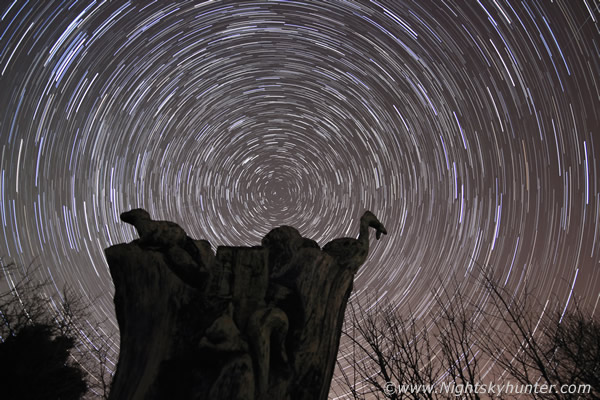 |
As the Earth spins eastwards a vigilant observer will notice that stars appear to set in the west and rise in the east at a specific speed known as ‘sidereal rate’. Stars located above the Earth’s polar axis will appear to rotate around our celestial pole in a counter clockwise direction centered on Polaris ‘The North Star’. This effect can be seen on any clear night by leaving the camera’s shutter open for a long period of time, this type of photography requires great patience, however it is only when the final image is complete that the photographer will often feel shocked at just how fast the ground on which he or she has stood is actually spinning. The image on the left was taken on March 11th 2015 from the ancient Drumlamph Woodland outside Maghera. Polaris is the star which exhibits the least amount of trailing and can be seen directly above the woodcut Badger and Heron carved into the famous tree stump which greets visitors on their walks.
|
Noctilucent Clouds
Noctilucent Clouds, (NLCs) or ‘Night Shining Clouds’ are a spectacular summertime phenomena. These mysterious clouds are thought to be connected with the solar cycle with active displays more often seen during solar minimum. (Solar minimum is the period of least solar activity in the eleven-year solar cycle of the sun). NLCs are located 82km high within the Mesosphere - literally on the edge of space - and manifest when ice crystals form on cosmic dust particles (a process called nucleation). These dust particles originate from ancient comets which have visited the inner solar system in the distant past. Once these clouds are seen they are never forgotten, a type 5 NLC display will exhibit electric blue colours and glow so bright that shadows are cast causing the countryside to glow under their eerie blue luminance.
Although there’s some controversy over when NLCs were first sighted the consensus now is that Thomas Romney Robinson made a first possible documented sighting from Armagh Observatory during May 1850. Another famous NLC observer Robert Leslie describes the phenomenon perfectly as '‘weird small cloud forms, at times very regular, like ripple marks in sand, or the bones of some great saurian embedded in a slab of stone'’.
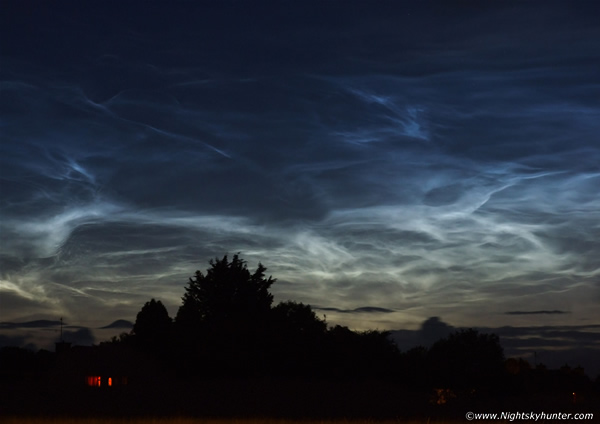 |
|
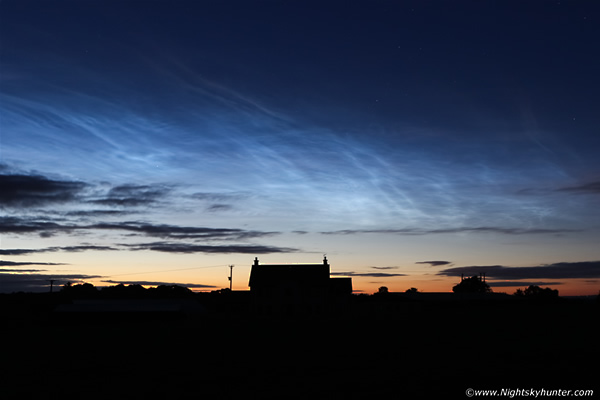 |
Maghera is located within the prime NLC visibility latitude range so I have seen many displays over the years. The 2009 season was particularly noteworthy for epic bright formations on many nights which coincided with low sunspot numbers. This display was captured just outside town near the Coleraine Road on June 18th 2009 with stunning complex forms which could be seen moving in real time as great alien-like bands and whirls which blocked out the stars in response to unseen gravity waves propagating through the mesosphere. This image was captured using my old 6mp bridge camera, it was a night I shall never forget. The image on the right was captured in more recent times on June 12th 2014 showing the class electric blue waves and bands taken from a hill to the north of Maghera where an isolated farm house can be seen.
Aurora Borealis/Northern Lights
If there is one sky phenomena which you must see in your life time then it would have to be the Aurora Borealis or Northern Lights. When you see the aurora you are witnessing a visual manifestation of the Earth being attacked from space. The phenomenon is violent, however the visual spectacle it produces is nothing short of spectacular. The genesis of the aurora can be found on the sun – a G2 Main Sequence Dwarf Star - a star midway through its life and just like us humans the sun can experience a mid-life crisis and become unpredictable. The result being unstable magnetic fields which produce openings in the corona (solar atmosphere) called Coronal Holes or extremely violent eruptions known as CMEs or Coronal Mass Ejections. CMEs and solar wind events originate from sunspots or from filament eruptions.
The sun waxes and wanes during an eleven year cycle and it is during solar maximum when these transient eruptions are more numerous. A fast CME can traverse 93 million miles of space in little more than 24 hours impacting the Earth’s magnetosphere triggering widespread aurora displays. The displays of 2000, 2002 and 2003 stand out in my mind as the finest auroras I have ever had the pleasure of seeing with the entire sky covered in rapidly pulsating pink and red coronal forms complimented by a multitude of green and purple rays which converged across the zenith causing the frost below me to glow red.
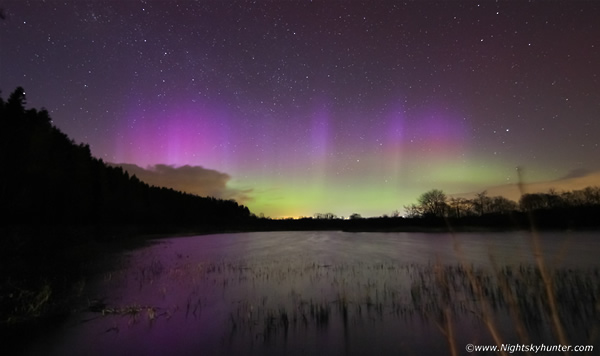 |
|
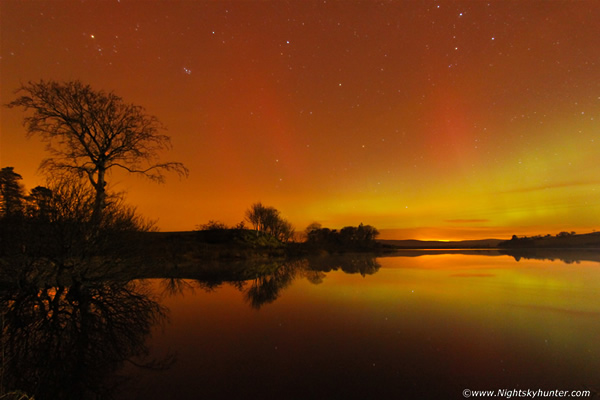 |
During this period there were strong auroras in the skies above Maghera every night for an entire week. All this activity was caused by multiple CMEs from a train of X-class flares (the biggest solar flares) associated with a sunspot which was so large that I could see it with the naked eye on the centre of the solar disk when it was setting behind the Sperrins as the sun descended into a bank of haze. The twin black spots looked like the barrels of a shotgun aimed directly towards Earth. I chase dark sites across the country with interesting foreground to make my aurora photography more interesting. I range from the Co. Antrim coast to the lakes and castles of Co. Fermanagh, however when I happen to catch one from Maghera it feels all the more special to me.
The above left was a recent example captured on April 7th 2016 just outside Maghera with the aurora reflecting upon the calm surface of Killyleagh Lough located between Maghera and Drumlamph. The pink and purple rays made for a splendid sight as Conor and I watched the stars fade and brighten as these vivid ghostly beams crossed the sky. On the right was Feb 27th 2014 when Paul Martin and I watched this incredible geomagnetic storm reflecting on Lough Fea (a 20 min drive from Maghera), this night generated a lot of excitement, the BZ had tilted to -30 for a long period of time and the resulting aurora was one of the finest shows in years, we had a journalist along with us too and this was her first ever aurora, she has never got over it and has been hooked ever since.
Aurora Borealis & Moonlit Snow
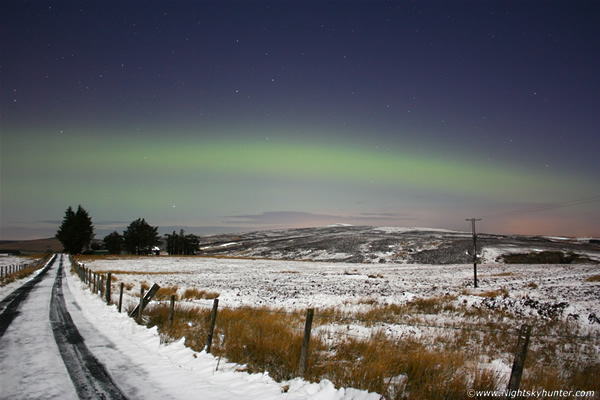 |
This was taken on Valentine’s night during 2010 from Glenshane Pass. This was a minor G1 (geomagnetic) storm however it’s the only time I have captured an aurora over snow from my home location which makes this one of greater sentimental value. The moon was at waxing gibbous phase which helped illuminate the snow which turned out great in a long exposure. I hope to some day get a better example of this beautiful combination of Earth weather and Space weather. |
Moonbows Or Lunar Rainbows
Have you ever seen a rainbow at night? These are called moonbows or lunar rainbows and Maghera is located in a country with an ideal climate for seeing these ghostly bows. The ingredients are an unstable post-frontal air mass behind a cold front with passing showers producing precipitation in the form of large water droplets and sufficient clear sky between showers. The moon needs to be behind you and bright, between gibbous and full phase, and located less than 42 degrees above the horizon. If conditions are ideal a moonbow will form on the shower in front of you at the lunar opposition point and with luck it will be visible among the stars for an extra surreal experience. Good displays will sport naked eye colours, even at night time.
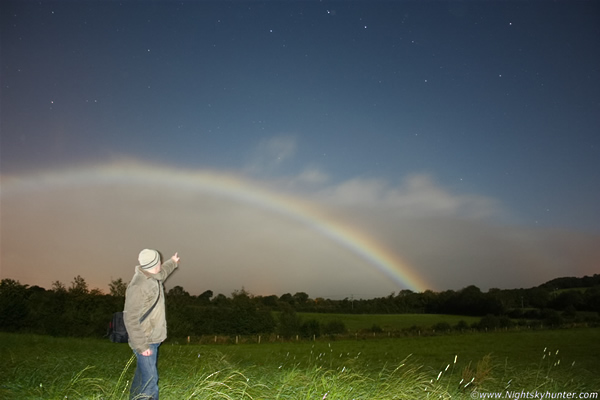 |
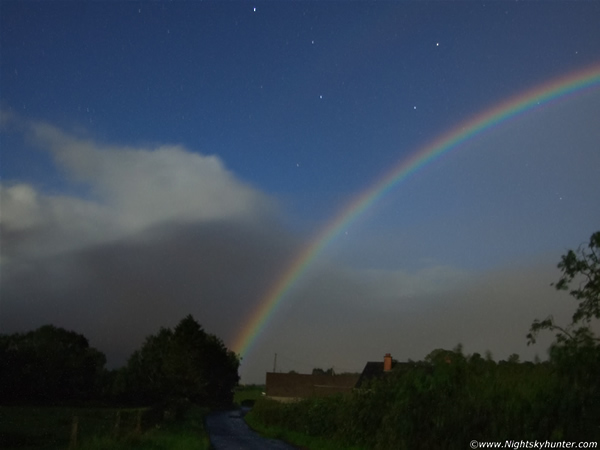 |
This was captured from Crewe Road outside Maghera on September 13th 2011, I simply had to get in the frame to celebrate this rare phenomenon, note the fainter secondary bow above the trees to the right of the primary. The image on the right was taken on the night of July 19th 2008 using my old Fujifilm S5600 bridge camera, this night produced the finest moonbows I have ever seen in my life with shocking naked eye colours and definition. I particularly liked this one taken at 02.00 from a country road adjacent to the Crewe Road, note the lunar supernumerary arcs and moonlit convective cell, there was a risk of thunderstorms, with the main bow over a country house with the stars within the Bowl of The Dipper complimenting the scene.
THUNDERSTORMS, MAMMATUS, FUNNEL CLOUDS & TORNADOES
One cannot be into Astronomy without understanding the weather as well. The two make for a delicate marriage with both parties fighting for dominance in a balancing act that can produce wonderful photogenic events for those tenacious enough to watch the skies. I have found Maghera to be a perfect location for storm chasing. It has always been my base of operations, for within five minutes I can be in the countryside and ready to shoot any dramatic cloudscapes which visit. The area also benefits from the close proximity of the Sperrins to the west and Slieve Gallion to the south while the flat lands of Antrim can offer good viewing vistas for monitoring low cloud bases while Lough Neagh itself offers all kinds of elemental wonders.
Thunderstorms require moisture, instability and lift in an atmospheric environment capable of allowing a parcel of air to rise vertically unimpeded. This process is called convection and requires sufficient surface heating near the ground and cold air aloft so a particle of air can rise high into the Troposphere. (The troposphere being the lowest, densest part of the Earth’s atmosphere). Irish thunderstorms can reach 30,000ft high however in some instances cloud tops on severe storms have been recorded at over 40,000ft high in this area.
Thunderstorms
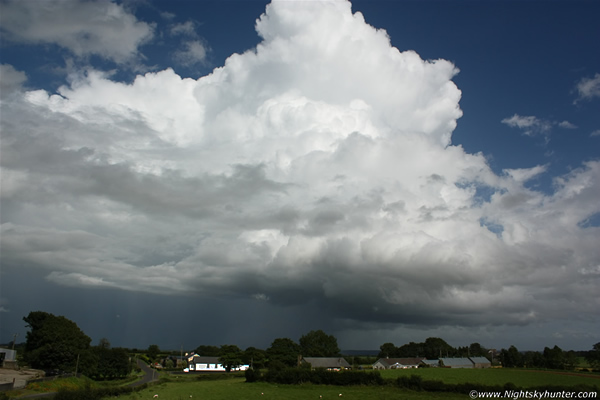 |
|
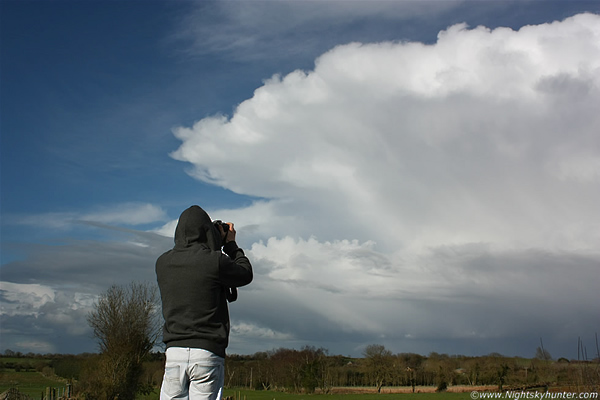 |
There are three main species of thunderstorm possible depending on the presence and type of wind shear present. These are: single cells, multicells and supercells. I live in a good area for thunderstorms as the landscape greatly aids with storm development. The role of the landscape is just as important as what goes on aloft. Hills and mountains act as a form of lift, forcing air to ascend, breaking any capping inversion, and rapidly forming storms. The Lough Neagh basin can provide an abundance of moisture for a storm to ingest while the Lough’s micro climate, converging winds and differential heating can produce vortex phenomena in the form of funnel clouds, waterspouts and tornadoes. In fact, historical records show many N. Ireland tornadoes have formed in proximity to Lough Neagh and hence were highly visible from Maghera.
Above left, August 21st 2012, on the Crewe Road outside Maghera looking east towards a beautiful multicell thunderstorm rumbling away. Note the solid updraught tower on the flank of the cell billowing upward in the heat in explosive fashion with crisp cloud tops in perfect sunlight. Wind shear has vented the precipitation away from the updraught base allowing for storm organisation and hence increased levels of severity. This storm would soon be causing flash flooding and property damage over Portglenone.
Above right, April 2nd 2011, that's my old storm chasing mate Conor McDonald documenting the flanking area of a beautiful multicell storm with strong anvil, this cell produced several episodes of rotation and would continue cross country until it reached the sea at the Antrim coast while still producing lightning. This day brings back good memories chasing with Conor and Declan O'Doherty, all three of us watching these storms near home, it was nice timing because Conor was heading for Australia the very next day and I was chasing trying to capture what I could before going on a date that same afternoon, the date was with Roisin who in years to come would be my Wife!
Funnel Clouds & Tornadoes
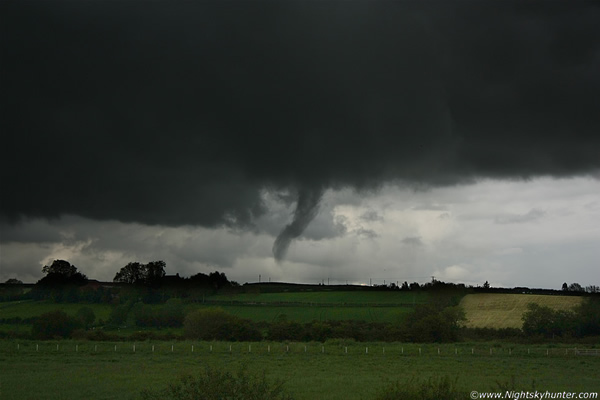 |
Funnel clouds and tornadoes can form under convection or maturing storms within convergence zones. Convergence zones are areas where wind from different directions meet causing lift and rotation. Conor McDonald and I saw our first funnel from Maghera on July 17th 2007 which was an unforgettable experience. The event was investigated by Dr. John Tyrrell from the Tornado And Storm Research Organisation (TORRO) who traveled from Cork to Maghera to study our images and chat with eye witnesses in the hope of finding a damage path. This one event got me hooked for life and spotting these Irish Twisters has become an obsession ever since. This funnel was captured on June 7th 2011 from the Glenshane Road, it never touched down, however the sight of the black funnel rotating over the green fields with hail stones falling and thunder roaring made for an exhilarating experience which had us buzzing for days. In the wake of this storm Declan O'Doherty and I spent several days knocking on local doors looking for witnesses who could either confirm or debunk if it had touched down. It was a fun time, many had seen the impressive storm clouds building however we were the only spotters to have reported it publicly. This image would appear in the local papers the following day which added to the fun. |
Funnel Clouds To The East & North Of Maghera
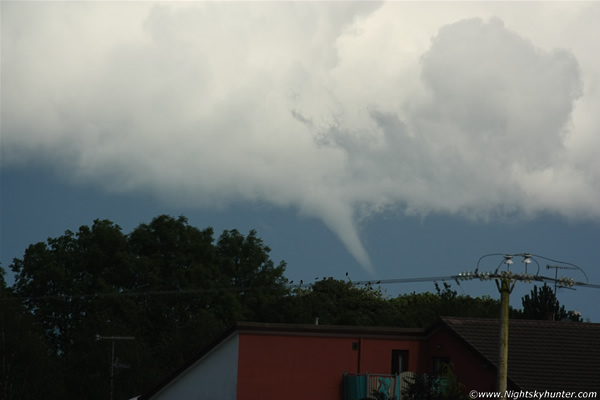 |
 |
The left photograph was taken on August 21st 2012 from Magher, with a telephoto lens under the base of strong towering cumulus cloud. This funnel was located over the Portglenone area and just recently a landowner contacted me about the image saying he saw it break tree branches in conjunction with a brief blast of hurricane force wind. In all likelihood this may have been a weak tornado. Observers should note that you do not need to see the funnel extending all the way to the ground for there to be a tornado present. The invisible vortex is often longer and wider than the visible condensation funnel and the vortex could already be doing damage on the surface even if the funnel is only half way to the ground. In contrast to this was the tornado of 2014 which formed over Lough Neagh and extended from cloud base to the surface throwing a modest spray bowl of water into the air as the waterspout trekked across the Lough in full view of many observers who captured it on camera.
Above right shows a recent capture from Maghera on June 24th 2016, this was once again captured with a 100-400mm telephoto lens from the top of the Crewe road outside Town. I knew this funnel was going to happen, the cells were good, hot and humid air, slack flow, local convergence and low cloud bases, I had only arrived on location five min's when this beautiful rope funnel cloud appeared rotating over the countryside beyond Drumlamph. My mate Conor McDonald also spotted it from his home and was excitedly explaining the funnel to his Gran who was visiting at the time, this was the second time Conor and I have independently seen a funnel at the same time since 2007.
Mammatus
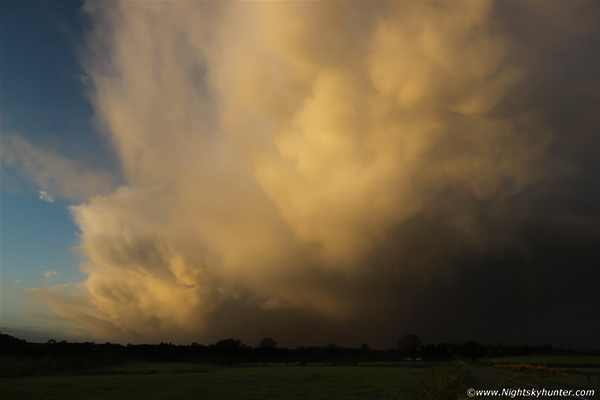 |
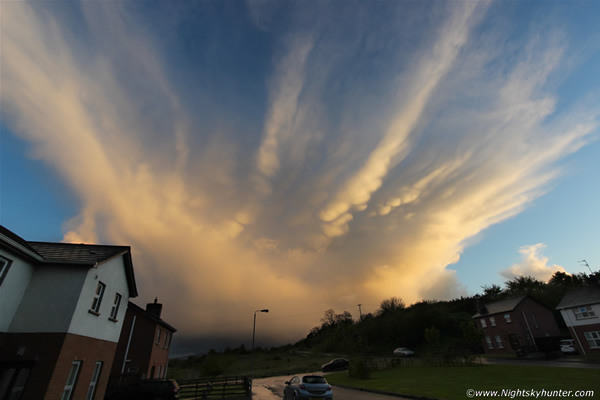 |
Always check the rear sector of clearing showers and thunderstorms for rainbows and mammatus clouds. Mammatus (mammary clouds) take the form of pouches or udders which form under the anvils of convective cells and are most spectacular near sunset when they are most often seen. They may be present when a cell has passed the mature stage and is on a downward trend. However, in some cases, when seen upwind on a storm’s anvil they can be a sign of severity. The above left was captured from Crewe Road, Maghera on May 11th 2015 when a storm with torrential rain cleared through putting on a dramatic cloud display with mamamtus lit into orange and gold by the setting sun. To the right was taken from my front garden in Maghera during May 18th 2015 at sunset just seven days after the first display, this display was spectacular with huge golden udders arranged in rows under the spreading anvil of a late evening cell which would cross Lough Neagh while rumbling during evening twilight.
Winter Nights & Days
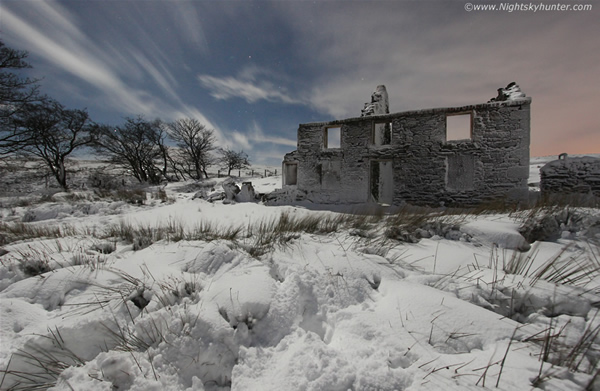 |
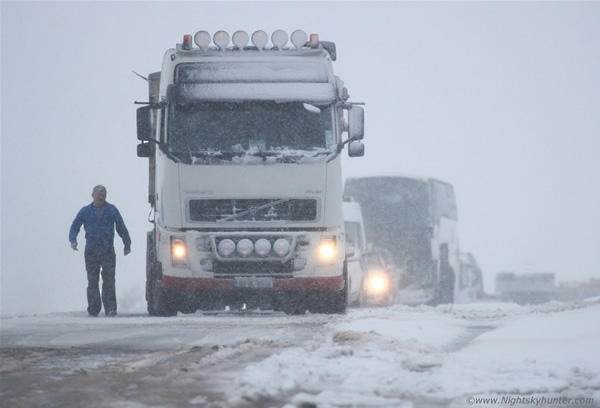 |
I love Winter weather. Who can forget the severe Winter of 2010 when Lough Neagh froze solid twice in a single season, or the festive sight of the numerous icicles which hung in great numbers from every shop and house in Maghera during the run up to Christmas. Blocking high pressure brought Arctic air south across the UK and Ireland bringing deep snowfalls, ice events, freezing rain and icicles which reached 6ft in length in the middle of the town. I recall one night recording a personal low of -18C which was quite incredible. The extreme blizzard on Glenshane Pass on March 30th the same year was one of the most outstanding Winter weather events I have ever experienced. We were lucky to make it back as many other motorists became trapped which involved a daring helicopter rescue. The following day 30ft snow drifts covered lay-bys and even a stranded bus was buried in snow up to windscreen level. Despite its tendency for disruption snow can be a welcome visitor on the hills outside Maghera and for photographers it can be a gem to get it in such abundance in comparison to other parts of the country.
This above left was taken on March 11th 2014 on Glenshane Pass at 03.00 UT during the course of a ten-hour photo shoot out in the elements. The haunting yet majestic ruins of this old house on the mountain looked dramatic surrounded by moonlit snow with stars aloft in the clean polar air. I recall setting my tripod in a 5ft snow drift to get set up. To the right was traffic mayhem on Glenshane Pass on February 14th 2013 when miles of traffic became stuck before rush hour on a Friday afternoon. The cause were several jack knifed trucks who's wheels spun in the snow, I was in that line of traffic which wasn't going anywhere so I got out for a few images to capture the action. When it comes to snow and storms Maghera is a special location close to my heart because it seems to never stop producing photogenic wonders when land and nature meet in such a dramatic communion.
Sunsets
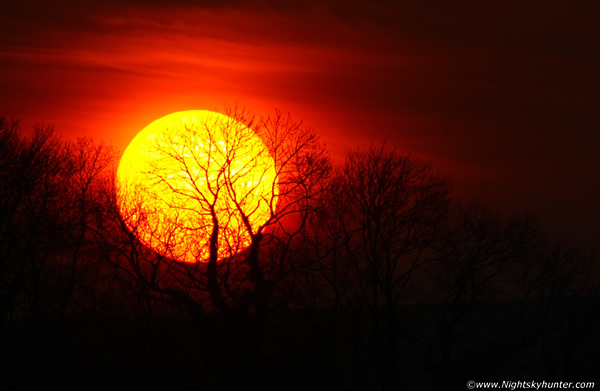 |
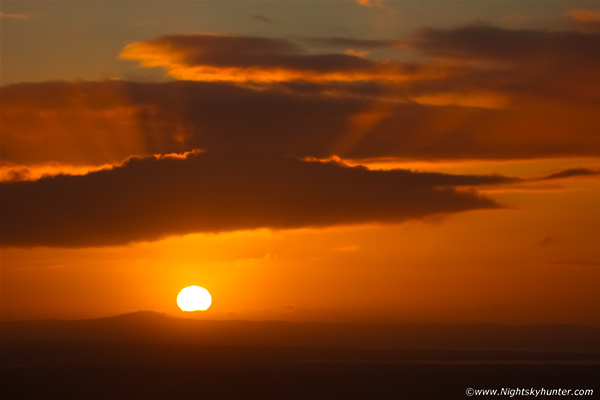 |
You don’t need storms to get photogenic weather, in fact, high pressure and several days of heat with the correct amount of haze can produce excellent opportunities to shoot the setting sun, the thicker haze acts like a filter obscuring the bright sunshine and allowing a rare chance of capturing the disk setting over the horizon. This was taken from the Maghera countryside on April 9th 2015 with a 400mm lens, you can clearly see a sunspot below centre on the solar meridian as the sun's disk set behind a line of trees adjacent to the Coleraine road. On the right was sunrise from Glenshane on February 3rd 2016, I was out this morning scanning for rare Nacreous Clouds but instead got treated to this wonderful sight, Maghera is below with Lough Neagh to the right and above sun rays fanned through the clouds. A word of caution – never ever look at the bright sun through binoculars or your camera’s viewfinder, always use a solar filter or your camera’s LCD screen to avoid permanent eye injury.
Drumlamph Once More
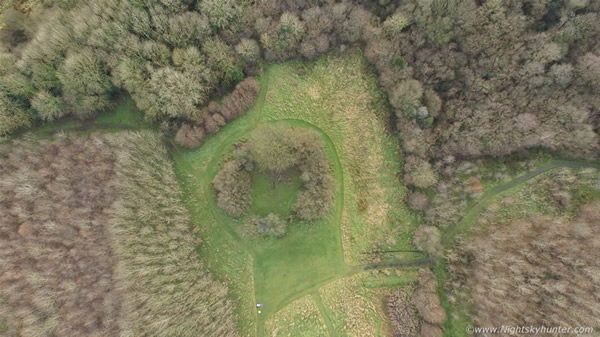 |
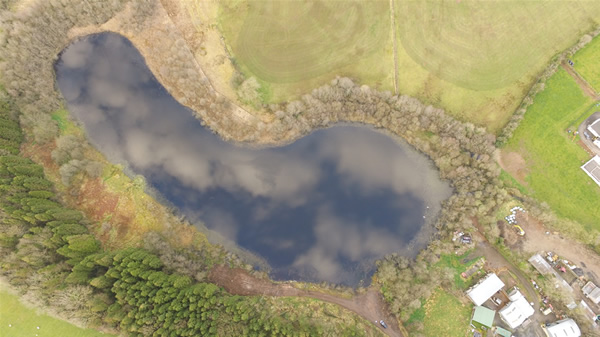 |
Since that Christmas morning back in 2004 when I got my first 1mp camera technology has advanced at an incredible rate with DSLRs cable of high ISO/low noise and fast lenses capable of catching the extraordinary detail within the Milky Way to mirrorless cameras capable of taking real time video of the aurora. In 2016 I am now in possession of quadcopter or 'drone' with fully integrated camera and gimbal combination which has allowed me to take my first steps with aerial photography, something which photographers could only dream about years ago. I will close this article where it began, from Maghera with Killyleagh Lough on the right and on the left from inside Drumlamph woodland, only this time the image was taken from above looking down on the ancient ring fort. Maghera is a wonderful location rich in history and character and if light pollution is kept in check then the town and countryside remain an excellent location for viewing the heavens and turning cameras skyward. Thanks very much for reading.
* This is a version of an article I wrote for 'The Maghera Times' which was published in the magazine during 2016 on behalf of the Maghera Historical Society. This edition of the Maghera Times and others can be purchased directly from the societies website or by visiting the head quarters in town.
Martin McKenna